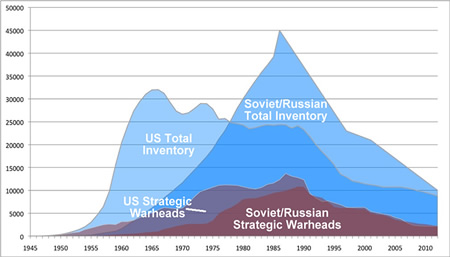 |
| Vast inventories of nuclear weapons remain after the Cold War arms race ended. |
.
By Hans M. Kristensen
Russia’s nuclear forces are expected to drop well below 500 offensive strategic delivery vehicles within the next five years, less than one-third of what’s permitted by the 1991 START treaty. Unless the next U.S. Nuclear Posture Review significantly reduces the number of land-based intercontinental ballistic missiles, that single leg of the U.S. Triad of nuclear forces alone could soon include more delivery vehicles than the entire Russian strategic arsenal of land- and sea-based ballistic missiles and long-range bombers. With this in mind, Russia is MIRVing its ballistic missile to keep some level of parity with the United States.
This and more from a briefing I gave this morning at the Arms Control Association meeting Next Steps in U.S.-Russian Nuclear Arms Reductions. I was in good company with Ambassador Linton Brooks, the former U.S. chief negotiator on the START treaty, who spoke about the key issues and challenges the START follow-on negotiators will face, and Greg Thielmann, formerly senior professional staffer of the Senate Select Committee on Intelligence, who discussed how the a new agreement might be verified through START-style verification tools.
Download: Briefing on US-Russian Nuclear Forces
.
While it is reasonable for governments to keep the most sensitive aspects of nuclear policies secret, the rights of their citizens to have access to general knowledge about these issues is equally valid so they may know about the consequences to themselves and their country.
Nearly one year after the Pentagon certified the Sentinel intercontinental ballistic missile program to continue after it incurred critical cost and schedule overruns, the new nuclear missile could once again be in trouble.
“The era of reductions in the number of nuclear weapons in the world, which had lasted since the end of the cold war, is coming to an end”
Without information, without factual information, you can’t act. You can’t relate to the world you live in. And so it’s super important for us to be able to monitor what’s happening around the world, analyze the material, and translate it into something that different audiences can understand.